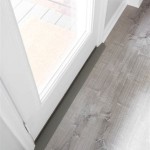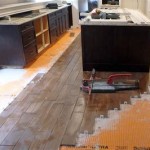Is Laminate Flooring Bad For Your Health? Unveiling the Potential Concerns
Laminate flooring has become a popular choice for homeowners due to its affordability, durability, and aesthetic versatility. It effectively mimics the look of hardwood, tile, or stone at a fraction of the cost. However, concerns have been raised regarding the potential health implications associated with laminate flooring, primarily stemming from its composition and manufacturing processes. This article will explore these concerns, examining the scientific evidence regarding health risks and providing a balanced perspective on the issue.
Laminate flooring typically consists of four layers: a wear layer, a decorative layer, a core layer, and a backing layer. The wear layer is a transparent coating made of aluminum oxide or melamine, providing scratch and stain resistance. The decorative layer is a photographic image that imitates the desired flooring material. The core layer, usually made of high-density fiberboard (HDF) or medium-density fiberboard (MDF), provides stability and impact resistance. The backing layer is a moisture-resistant material that protects the core from water damage.
The health concerns associated with laminate flooring largely revolve around the composition of the core layer, particularly the presence of formaldehyde-based resins used as adhesives. Additionally, the potential for volatile organic compound (VOC) emissions from the flooring materials and installation adhesives raises concerns about indoor air quality. It's crucial to understand these potential exposures and the associated risks to make informed decisions about flooring choices.
Formaldehyde Emissions and Potential Health Effects
Formaldehyde is a colorless, pungent gas used extensively in the manufacturing of building materials, including laminate flooring. It is a known irritant and has been classified as a probable human carcinogen by the International Agency for Research on Cancer (IARC). Formaldehyde is used as a binder in the resins that hold together the wood fibers in the HDF or MDF core of most laminate floors.
Exposure to formaldehyde can occur through inhalation of airborne particles released from the flooring material, a process known as off-gassing. The intensity of off-gassing typically decreases over time, with the highest emissions occurring shortly after installation. Factors influencing formaldehyde emissions include the type and amount of resin used, the manufacturing process, the age of the flooring, temperature, and humidity levels. Higher temperatures and humidity can accelerate the off-gassing process.
The health effects of formaldehyde exposure vary depending on the concentration and duration of exposure. Short-term exposure can cause irritation of the eyes, nose, and throat, as well as coughing, wheezing, and skin rashes. Individuals with pre-existing respiratory conditions, such as asthma, may be more susceptible to these effects. Long-term exposure to higher concentrations of formaldehyde has been linked to an increased risk of certain types of cancer, particularly nasopharyngeal cancer and leukemia.
Recognizing the potential risks, regulations and standards have been implemented to limit formaldehyde emissions from building materials. In the United States, the Formaldehyde Standards for Composite Wood Products Act requires that all composite wood products sold or manufactured in the country meet specific formaldehyde emission standards. The California Air Resources Board (CARB) has also established stringent emission standards for formaldehyde in composite wood products. These regulations aim to protect public health by reducing formaldehyde exposure from laminate flooring and other wood-based materials.
Volatile Organic Compounds (VOCs) and Indoor Air Quality
In addition to formaldehyde, laminate flooring can emit other volatile organic compounds (VOCs), a broad category of organic chemicals that evaporate at room temperature. VOCs can be released from the flooring material itself, as well as from the adhesives used during installation. Common VOCs found in laminate flooring include benzene, toluene, ethylbenzene, and xylene (BTEX) and phthalates.
VOCs can contribute to indoor air pollution and may have a variety of adverse health effects. Short-term exposure to VOCs can cause headaches, dizziness, fatigue, nausea, and irritation of the eyes, nose, and throat. Long-term exposure has been linked to more serious health problems, including respiratory illnesses, neurological damage, and cancer. The severity of health effects depends on the type and concentration of VOCs, as well as the duration of exposure and individual susceptibility.
The level of VOC emissions from laminate flooring can vary depending on the manufacturing process, the materials used, and the age of the flooring. Newly installed flooring typically emits higher levels of VOCs, which gradually decrease over time. Proper ventilation can help to reduce VOC concentrations in indoor environments. Opening windows and using air purifiers can improve air circulation and remove pollutants.
To minimize VOC exposure, consumers can choose low-VOC or VOC-free laminate flooring products. Look for products that have been certified by reputable organizations, such as GreenGuard or FloorScore. These certifications indicate that the flooring has been tested and meets specific emission standards for VOCs. When installing laminate flooring, use low-VOC adhesives and sealants to further reduce potential exposure.
Dust and Particle Exposure from Laminate Flooring Wear
While formaldehyde and VOC emissions are the most frequently cited health concerns with laminate flooring, another potential issue is the generation of dust and particles due to wear and tear. As the wear layer breaks down over time, microscopic particles can be released into the air. These particles can be inhaled, potentially leading to respiratory irritation or other health problems, especially if the particles contain harmful substances.
The composition of these particles depends on the materials used in the wear layer and the underlying decorative layer. Some laminate floors may contain melamine resins or aluminum oxide, which can be irritating if inhaled. Additionally, if the decorative layer contains pigments or dyes that are not properly bound, these substances could also be released as dust particles. Some older laminates may even contain lead in the ink of the decorative layer, though this is less common in products manufactured to current standards.
Regular cleaning and maintenance can help to minimize dust and particle exposure from laminate flooring. Dusting with a microfiber cloth and vacuuming with a HEPA filter can effectively remove dust and debris. Avoid using harsh chemicals or abrasive cleaners, as these can damage the wear layer and accelerate particle release. Consider using floor mats or rugs in high-traffic areas to protect the flooring from wear and tear. Furthermore, ensuring proper ventilation can help to remove airborne particles from the indoor environment.
Choosing higher-quality laminate flooring with a durable wear layer can also reduce particle generation. Look for products with a high abrasion resistance (AC) rating, which indicates the flooring's ability to withstand wear and tear. Laminate floors with higher AC ratings are more resistant to scratches, scuffs, and fading, and are less likely to release particles over time.
Ultimately, the decision of whether or not to install laminate flooring involves weighing the potential benefits against the potential risks. By understanding the potential health concerns associated with laminate flooring, exploring product certifications, and implementing appropriate mitigation strategies, homeowners can make informed choices to create a healthier indoor environment.

Non Toxic Laminate Flooring Brands Formaldehyde Free My Chemical House

Are Vinyl Floors Toxic Olde Tyme Floor

Disadvantages Of Laminate Wood Flooring Key Drawbacks

Why Some Laminate Floors Were Making People Sick 5 21 2025

The Dangers Of Luxury Vinyl Floors Lvt And How You Can Avoid Them Artisan Wood Llc

Is Wood Flooring Bad For Your Health Singapore

The Ultimate Guide To Non Toxic Flooring Atkinson Kirby
Non Toxic Laminate Flooring Brands Formaldehyde Free My Chemical House

Disadvantages Of Laminate Wood Flooring Key Drawbacks

Is Engineered Hardwood Better For Health 50floor
Related Posts








